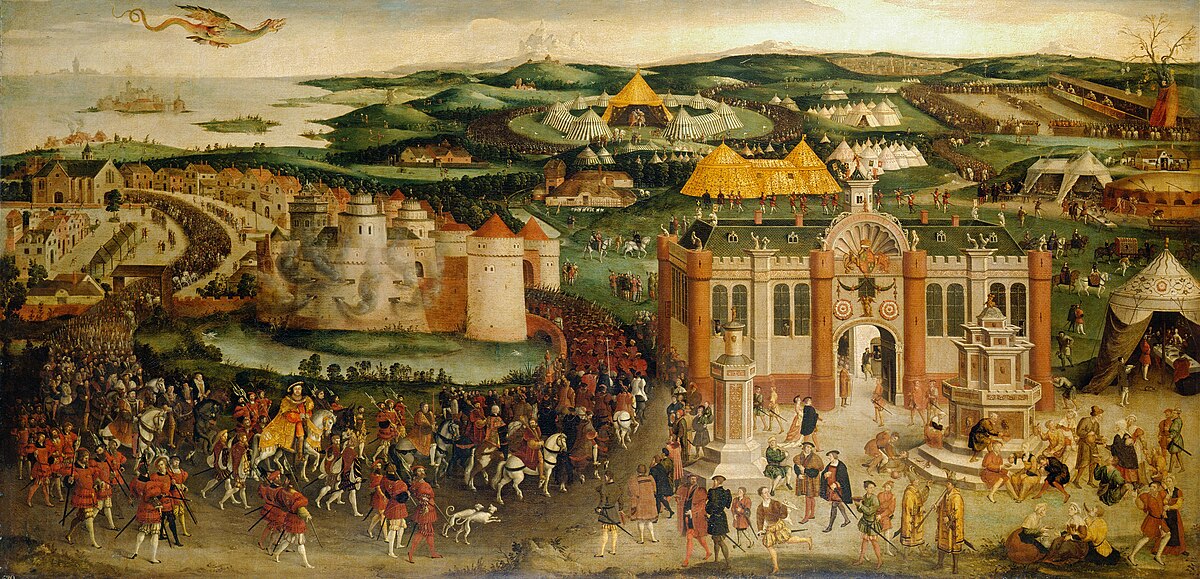The Field of Cloth of Gold: Rivalry, Splendor, and Diplomacy in Tudor Europe

Introduction: A Summit Like No Other
In June 1520, the kings of England and France—Henry VIII and Francis I—met in a dazzling display of power, wealth, and political showmanship near Calais, in what would become known as the Field of Cloth of Gold. This extravagant summit was not a battle, but a diplomatic encounter steeped in luxury, spectacle, and rivalry, designed to cement peace between two old enemies. Yet behind the festivities lay tense undercurrents of power politics, international alliances, and personal ego.
This article explores the causes, events, and lasting impact of this extraordinary encounter, often called one of the most ostentatious meetings in diplomatic history.
1. Setting the Stage: Europe in the Early 16th Century
The early 1500s were a time of great upheaval and ambition in Europe:
- The Italian Wars raged, with France and the Habsburg Empire vying for dominance.
- England, under the young and energetic Henry VIII, sought to assert itself as a major European power.
- The Pope, the Holy Roman Emperor Charles V, and the Ottoman Empire all played complex roles in shaping the balance of power.
Henry VIII and Francis I, both ambitious and flamboyant monarchs, saw themselves as rivals for glory and leaders of the Renaissance world. A public demonstration of friendship and parity would signal to other powers—especially Charles V—that England and France could unite, even if briefly.
2. Why “Cloth of Gold”? Origins and Objectives
The idea for a grand summit came from Cardinal Thomas Wolsey, Henry VIII’s chief advisor, who sought to broker peace in Europe and elevate England’s diplomatic standing. The event’s name comes from the elaborate golden fabrics used in tents, clothing, and decorations, meant to dazzle both audiences and adversaries.
The meeting aimed to:
- Promote peace between England and France
- Showcase wealth and power through Renaissance spectacle
- Secure alliances through personal diplomacy and pageantry
- Balance England’s relationships with both France and the Holy Roman Empire
3. Location and Logistics: A City of Silk and Splendor
The Field of Cloth of Gold was held in a valley near Calais, technically English territory, close to the French border. What emerged was a temporary city of tents, palaces, fountains, and feast halls, constructed over several weeks:
- A temporary palace for Henry VIII was erected with brick foundations, wood walls, and gilded fabric.
- Over 5,000 English attendants traveled with Henry, including nobles, knights, and servants.
- Tents were decorated with cloth of gold, velvet, satin, and brocade, and some were topped with gilded spires.
- Even the wine fountains ran freely, and golden dinnerware was used for feasts.
4. The Main Events: Feasting, Jousting, and Bonding
The summit lasted from June 7 to June 24, 1520, and included:
- Daily banquets with hundreds of dishes and musical entertainment
- Jousts, archery contests, and wrestling matches, with both kings participating
- Masses and processions showcasing religious devotion
- Cultural exchanges involving art, music, and gifts
One of the most memorable incidents was when Henry VIII challenged Francis I to a wrestling match—and lost. Though lighthearted, it reflected the subtle rivalry that permeated the event.
5. Beneath the Surface: Rivalry More Than Unity
Despite the public show of camaraderie, the event failed to produce lasting diplomatic results. While the two kings vowed mutual support, trust was thin, and politics quickly intervened:
- Charles V, the Holy Roman Emperor, viewed the summit with suspicion and soon visited Henry to secure his own alliance.
- Within two years, England sided with Charles against France, and the earlier friendship dissolved.
The Field of Cloth of Gold ultimately became a symbol of performative diplomacy, where appearances masked deeper tensions.
6. Legacy: Splendor Remembered, Outcomes Forgotten
Though the political outcomes were limited, the Field of Cloth of Gold left a lasting cultural impact:
- It demonstrated the rise of personal monarchy, where the king’s image was central to power.
- It became a template for later diplomatic spectacles, influencing royal courts across Europe.
- It highlighted the competitive nature of Renaissance rulers, who blended art, fashion, and warfare in their pursuit of glory.
Today, the Field of Cloth of Gold remains a fascinating example of diplomacy through theatre, showing how rulers used wealth and pageantry not just to impress, but to intimidate and outshine.
Conclusion: When Kings Played Peacocks
The Field of Cloth of Gold stands as a testament to human grandeur, rivalry, and ambition. It was a meeting where golden tents and glittering armor replaced guns and swords—if only temporarily. Though the peace it promised was short-lived, the event remains one of the most lavish and memorable summits in European history, a shining moment when two Renaissance titans tried to outshine each other—not with war, but with silk, song, and splendor.




